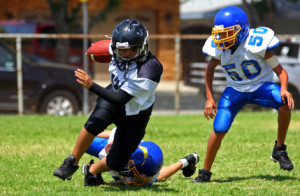What Athletes Need to Know About Sports-Related Neck Injuries
From college and NFL football to the NBA and NHL, sports season is in full-swing. However, you don’t have to be a pro-athlete to be concerned about sports-related neck injuries. Plenty of kids and teenagers are participating in sports this fall, too.
While many parents are aware of the potential dangers of their children playing contact sports, it’s also important to understand how these activities affect the body in order to prevent a major spinal cord injury from happening.
As we know, the neck is part of the vertebrae, the long column of bones and soft tissues that run down the back, and its purpose is to connect the head and spine, and create a balance between the two. The spinal cord is located in the middle of the cervical spine, although it is connected to the neck through the vertebrae. It is very vulnerable, and if it gets injured, it can cause a variety of devastating medical problems.
Contact sports, such as football, or wrestling, can contribute to several different neck injuries including neck fractures and spinal cord injuries (SCIs). Neck fractures are the most common sports related neck injury, and in most cases, it can be easily treated. Sometimes, however a neck fracture can lead to a more severe SCI, which may result in paralysis or worse, death.
- Sports-related cervical injuries can be categorized in the following terms:
- Acute cervical sprains/strains including whiplash injury
- Cervical fractures and dislocations
- Nerve root or brachial plexus injuries
- Intervertebral disc injuries
- Cervical stenosis
Good athletic programs and coaches are normally well versed in ways to participate in a contact sport while limiting the occurrence of severe injury. Sports involving rough, direct physical contact such as football, ice hockey, and rugby carry a higher risk of neck injury, so it’s important for the participant to be conscious of his body while playing. Understanding how to perform specific maneuvers while protecting neck injuries can also occur in several non-contact sports such as skiing, swimming, diving, surfing, and horseback riding, so it’s important to take the necessary precautions and safety measures before participating.
While treatable, a neck fracture can result in a severe medical emergency, and can possibly change your mobility for life. You may be suffering from a fractured neck if you experience the following:
- Pain, which may or may not be severe
- Pain radiating from the neck down to the shoulders and/or arms
- Swelling and bruising
- Tenderness
- Decreased feeling in the arms, legs or body
- Muscle weakness or paralysis of the arms or legs
It is important to understand how to protect one’s self and loved ones from neck and spinal cord injuries. While it may not be an overwhelming priority in terms of overall healthcare, the potential damage from these injuries is too severe to ignore. As always, consult your physician before beginning any strenuous activities or workouts, and follow our blog for more great advice!

Categories
Archives
Contact Dr. Mudit Sharma
Phone: (571) 921-4877
Toll Free: (855) 774-6334
Monday – Thursday: 8am – 4pm
Friday: 8am – 2pm
Fredericksburg
4604 Spotsylvania Parkway, Suite 300 Fredericksburg, VA 22408
Manassas
8650 Sudley Road, Suite 315
Manassas, VA 20110-4418

